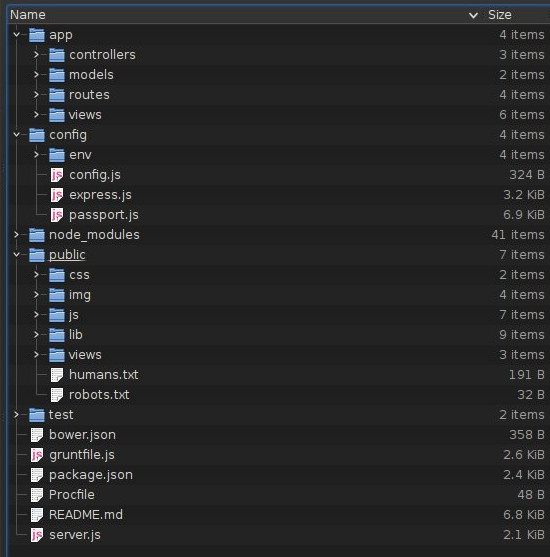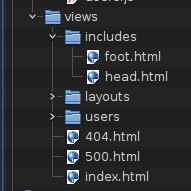Explore the MEAN Stack: Introduction
Building web applications involves having to use different technologies and tools to handle database operations, server-side operations, and client-side operations Process and display data from the server. before starting A new project, all tools and project structure must be set up, this is Time-consuming tasks. Using a framework or stack to perform this task can speed things up Develop and ease the work of developers.
What is average
"MEAN is a full-stack JavaScript platform for modern web applications."
This is how the authors of the MEAN stack define it on their website. It's clear that MEAN is aimed at JavaScript developers of all kinds (server-side and client-side), and it's a stack platform means it is made up of multiple components.
The components are:
- MongoDB
- express delivery
- AngularJS
- NodeJS
As you can see, MEAN brings together four of the most used and appreciated JavaScript development technology lays the foundation for easy development Build complex web applications.
Install
MEAN stack can be installed in two ways:
- Use mean.io website
- Use various Yeoman generators.
Install MEAN using its site
This method is very simple. All you need to do is visit
mean.io website and you can download the framework
zip file, click the big green button.
Another option available here is to clone the Git repository. Just open one Terminal and issue the following command:
git clone https://github.com/linnovate/mean.git
Use Yeoman to install MEAN
There are several Yeoman generators, written by different people Developer. Installing MEAN using the generator is done in two steps, first Install generator:
npm install -g generator-meanstack
Then use yo to create the application:
yo meanstack
The above example assumes that the meanstack generator is installed, and that Yeoman is also installed. For a list of MEAN generators, check this
Link and filter by "Average". for
For information about installing Yeoman, check out the Yeoman website.
Addy Osmani wrote a very interesting blog post About the MEAN stack and Yeoman generators. I highly recommend you read that article to learn how to install a stack using a generator.
For the purposes of this article, I will be using the Git clone method.
After installation
After installation, just put cd into the folder where the MEAN stack is installed
and issue the grunt command (you should have grunt-cli installed). this
The command will start a server listening on port 3000, so access
http://localhost:3000 The following content will be displayed in the browser:

What do we get after installation
MEAN stack is actually a fully functional blogging engine application. it has Authenticate using various methods: Facebook, GitHub, Twitter or Google and Also via simple email and password.
I bet by now you're dying to see some code... so let's take a look. mean The stack folder structure should look like this:

Server part
The server is divided into two folders and one file:
-
appfolder - contains the controllers, models, and views that make upappapplication -
configFolder - Contains files that control various parts of the application Be well behaved -
server.js- is the entry point of the application
Let’s take a look one by one:
server.js File
This is the file that starts the entire application. If you don't want to use
grunt You can use node server,js to start the server.
server.js File responsible:
- Loading configuration. files used to configure the application itself, Authentication and database connections are loaded.
- Bootstrap model. This is done by iterating over the model folders Load all files within this folder (or its subdirectories).
- GUIDE PASSPORT
- Initialize the express application
- Configure the express application
- Configure quick application route
- Start listening on the configured port.
config Folder
This folder contains application configuration files. inside you can find a
env Folder containing configurations for development, production and testing
The mode in which the application is run.
Additionally, there are files containing the configuration of the application itself, Express section and passport configuration for login.
app Folder
In the app folder, the entire server-side code is stored. this folder
Subfolders containing the controllers, models, and views that make up MVC
Folders for server applications and provided routes.
By default, there are controller and index files for articles, users root path. Additionally, models and routes for articles and users were created Article, user, and root paths are created during installation.
For views created by default, the following structure will be created:

includes folder contains the footer and header portion of the page
is inserted into all pages belonging to the application. layout Folder
Contains basic HTML for page layout. This layout extends from the views folder to the index.html file.
users folder contains markup code for login, registration and login
Verifying.
In the root directory of the views folder, next to the index.html file, there is the file
Contains flags for 404 and 500 errors.
Client part
The client part code is located in the public folder. This folder contains a
css Subfolder for application styles and img folder containing images
used in the application.
Special attention should be paid to the js folder, where
Contains Angular code, initialization code, etc. for the client application
directive and filter code (currently an empty file) and controller and
Serves the article and title sections of the application. views
The folder contains tags for article creation, editing, display, and
Check.
Finally, the lib folder contains the Angular library code.
Application Test
Thetest folder contains files for testing the application. There are
is the file that uses Mocha to test the server part and is used for testing
Using the client side of Karma.
Tools provided
When using the MEAN stack, you as a developer also have access to npm, bower, and grunt, among which Should be installed,
It is worth mentioning that JSHint has been provided, and all JavaScript code has been provided Hair loss. Additionally, using Grunt, you can monitor your project for modifications and Automatically rebuild.
in conclusion
This article is intended as a follow-up to the second tutorial, in which the complete Applications will be built on top of the MEAN stack, showing you how MEAN can Configure and adjust for use in other types of applications.
Stay tuned the second part!
The above is the detailed content of Explore the MEAN Stack: Introduction. For more information, please follow other related articles on the PHP Chinese website!

Hot AI Tools

Undresser.AI Undress
AI-powered app for creating realistic nude photos

AI Clothes Remover
Online AI tool for removing clothes from photos.

Undress AI Tool
Undress images for free

Clothoff.io
AI clothes remover

AI Hentai Generator
Generate AI Hentai for free.

Hot Article

Hot Tools

Notepad++7.3.1
Easy-to-use and free code editor

SublimeText3 Chinese version
Chinese version, very easy to use

Zend Studio 13.0.1
Powerful PHP integrated development environment

Dreamweaver CS6
Visual web development tools

SublimeText3 Mac version
God-level code editing software (SublimeText3)

Hot Topics
 1378
1378
 52
52
 Is WordPress easy for beginners?
Apr 03, 2025 am 12:02 AM
Is WordPress easy for beginners?
Apr 03, 2025 am 12:02 AM
WordPress is easy for beginners to get started. 1. After logging into the background, the user interface is intuitive and the simple dashboard provides all the necessary function links. 2. Basic operations include creating and editing content. The WYSIWYG editor simplifies content creation. 3. Beginners can expand website functions through plug-ins and themes, and the learning curve exists but can be mastered through practice.
 What is the WordPress good for?
Apr 07, 2025 am 12:06 AM
What is the WordPress good for?
Apr 07, 2025 am 12:06 AM
WordPressisgoodforvirtuallyanywebprojectduetoitsversatilityasaCMS.Itexcelsin:1)user-friendliness,allowingeasywebsitesetup;2)flexibilityandcustomizationwithnumerousthemesandplugins;3)SEOoptimization;and4)strongcommunitysupport,thoughusersmustmanageper
 Can I learn WordPress in 3 days?
Apr 09, 2025 am 12:16 AM
Can I learn WordPress in 3 days?
Apr 09, 2025 am 12:16 AM
Can learn WordPress within three days. 1. Master basic knowledge, such as themes, plug-ins, etc. 2. Understand the core functions, including installation and working principles. 3. Learn basic and advanced usage through examples. 4. Understand debugging techniques and performance optimization suggestions.
 Should I use Wix or WordPress?
Apr 06, 2025 am 12:11 AM
Should I use Wix or WordPress?
Apr 06, 2025 am 12:11 AM
Wix is suitable for users who have no programming experience, and WordPress is suitable for users who want more control and expansion capabilities. 1) Wix provides drag-and-drop editors and rich templates, making it easy to quickly build a website. 2) As an open source CMS, WordPress has a huge community and plug-in ecosystem, supporting in-depth customization and expansion.
 How much does WordPress cost?
Apr 05, 2025 am 12:13 AM
How much does WordPress cost?
Apr 05, 2025 am 12:13 AM
WordPress itself is free, but it costs extra to use: 1. WordPress.com offers a package ranging from free to paid, with prices ranging from a few dollars per month to dozens of dollars; 2. WordPress.org requires purchasing a domain name (10-20 US dollars per year) and hosting services (5-50 US dollars per month); 3. Most plug-ins and themes are free, and the paid price ranges from tens to hundreds of dollars; by choosing the right hosting service, using plug-ins and themes reasonably, and regularly maintaining and optimizing, the cost of WordPress can be effectively controlled and optimized.
 Why would anyone use WordPress?
Apr 02, 2025 pm 02:57 PM
Why would anyone use WordPress?
Apr 02, 2025 pm 02:57 PM
People choose to use WordPress because of its power and flexibility. 1) WordPress is an open source CMS with strong ease of use and scalability, suitable for various website needs. 2) It has rich themes and plugins, a huge ecosystem and strong community support. 3) The working principle of WordPress is based on themes, plug-ins and core functions, and uses PHP and MySQL to process data, and supports performance optimization.
 Is WordPress a CMS?
Apr 08, 2025 am 12:02 AM
Is WordPress a CMS?
Apr 08, 2025 am 12:02 AM
WordPress is a Content Management System (CMS). It provides content management, user management, themes and plug-in capabilities to support the creation and management of website content. Its working principle includes database management, template systems and plug-in architecture, suitable for a variety of needs from blogs to corporate websites.
 Is WordPress still free?
Apr 04, 2025 am 12:06 AM
Is WordPress still free?
Apr 04, 2025 am 12:06 AM
The core version of WordPress is free, but other fees may be incurred during use. 1. Domain names and hosting services require payment. 2. Advanced themes and plug-ins may be charged. 3. Professional services and advanced features may be charged.




